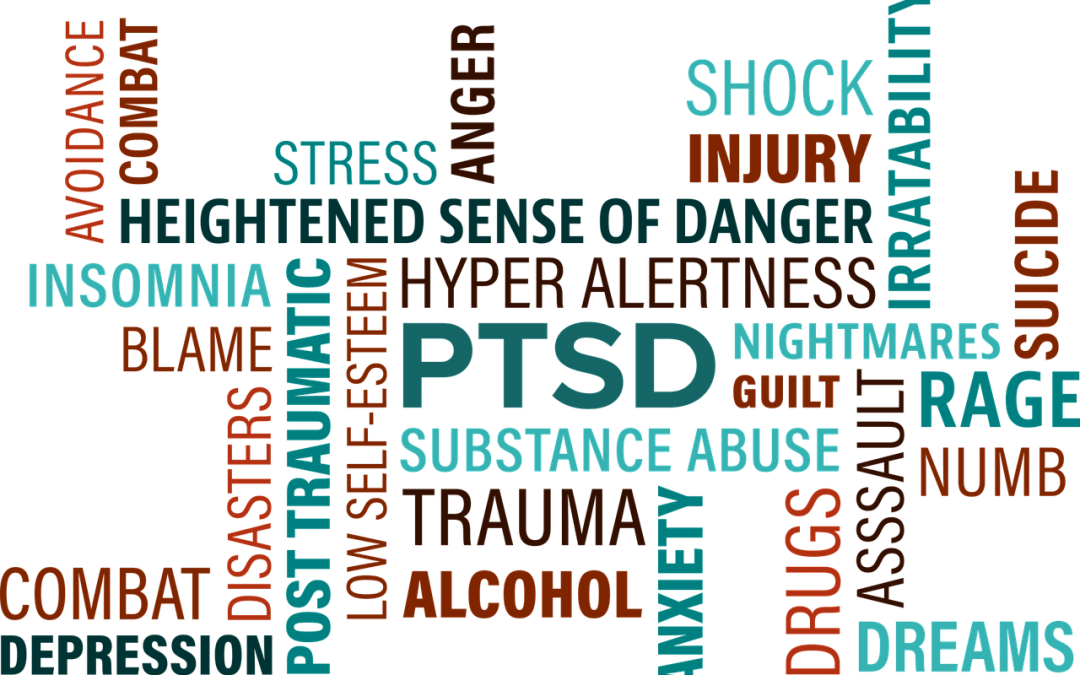PTSD, the Olfactory System and Essential Oils
By Rehne Burge, Certified Aromatherapist
NAHA Director for Louisiana
Soul Essentials Duo
Aromatherapy by Soul Essentials Duo (Facebook Group)
PTSD, once referred to as “shell shock” or battle fatigue, was first brought to attention by war veterans, and is a result of a direct traumatic, tragic or a terrifying event that one has witnessed or experienced in their lives. This not only effects Veterans but also people that have experienced a tragic or traumatic event. Being frightened under these circumstances is normal. Fear triggers many split-second changes in the body to help defend against danger or to avoid it. This “fight-or-flight” response is a typical reaction meant to protect a person from harm. Nearly everyone will experience a range of responses after trauma, yet most people recover from initial symptoms naturally. Those who continue to experience problems may be diagnosed with PTSD. People who have PTSD may feel stressed or frightened whether danger is present or not. From my personal experience, this can occur at any given time, without notice. There is usually persistent frightening thoughts and memories of their ordeal and a feeling of being emotionally numb, especially with people they were once close to. (1)
Some people, unaware, will block the trauma and have their memory come back at a later time in life, leaving them even further traumatized. Most people with post-traumatic stress disorder (PTSD) repeatedly re-live the trauma in the form of nightmares, panic attacks, anxiety and disturbing recollections during the day. The nightmares or recollections may come and go, and a person may be free of them for weeks at a time, and then experience them daily for no particular reason. This can occur whether the person remembers the trauma or not. It can sit idly by with no memory, yet the symptoms can still take place.
A person with PTSD may also experience sleep problems, depression, substance abuse, feeling detached or numb, or being easily startled. As previously mentioned, there is the possibility of also loosing memory or cognition. They may lose interest in things they used to enjoy and have trouble feeling affectionate. They may feel irritable, more aggressive than before, or even violent. Seeing things that remind them of the incident may be very distressing, which could lead them to avoid certain places or situations that bring back those memories. Anniversaries of the event are often very difficult. The disorder is also associated with impairment of the person’s ability to function in social or family life, including occupational instability, marital problems and divorces, family discord, and difficulties in parenting.
What is Fear?
Fear is a feeling induced by perceived danger or threat that occurs in certain types of organisms, which causes a change in metabolic and organ functions and ultimately a change in behavior, such as fleeing, hiding, or freezing from perceived traumatic events. Or, in simpler terms, it’s an unpleasant emotion caused by the belief that someone or something is dangerous, likely to cause pain, or that may feel like a threat. Fear in human beings may occur in response to a specific stimulus occurring in the present, or in anticipation or expectation of a future threat perceived as a risk to body or life. The fear response arises from the perception of danger leading to confrontation with or escape from/avoiding the threat (also known as the fight-or-flight response), which in extreme cases of fear (horror and terror) can be a freeze response or paralysis. In the midst of my own panic attacks, I become so frightened of the visions that I scurry from anyone coming near me during an attack.
In humans and animals, fear is modulated by the process of cognition and learning. Thus fear is judged as rational or appropriate and irrational or inappropriate. An irrational fear is called a phobia.
Fear can cause a chain reaction in the brain that starts with a stressful stimulus, which can be any change or signal in the environment that can make an organism react in some way and end with the release of chemicals that cause a racing heart, fast breathing and energized muscles, among other things, also known as previously mentioned, the fight-or-flight response. When this occurs, it causes a change in metabolic and organ functions and ultimately a change in behavior such as fleeing, hiding, or freezing from perceived traumatic events. The stimulus could be a spider, a knife at your throat, trauma of many sorts from war to child abuse or an auditorium full of people waiting for you to speak or the sudden thud of your front door against the door frame.
More than 100 billion nerve cells comprise an intricate network of communications that is the starting point of everything we sense, think and do and this makes the brain a very complex and quite amazing organ. Some of these communications lead to conscious thought and action, while others produce autonomic responses. The fear response is almost entirely autonomic: We don’t consciously trigger it or even know what’s going on until it has run its course.
Cells in the brain (neurons) are constantly transferring information through a thread like extension of a neuron called a dendrite that carries nerve impulses toward the cell body and triggers responses. There are dozens of areas of the brain at least peripherally involved in fear. But research has discovered that certain parts of the brain play central roles in the process:
SLXLM
- Thalamus – relays information to the cortex, processes and filters information and decides where to send incoming sensory data (from eyes, ears, mouth, skin)
- Sensory cortex –located in the parietal lobe and interprets sensory data
- Hippocampus – The hippocampus is a major component of the brains of humans and other vertebrates. Humans and other mammals have two hippocampuses, one in each side of the brain. The hippocampus belongs to the limbic system and plays important roles in the consolidation of information from short-term memory to long-term memory, and in spatial memory that enables navigation stores and retrieves conscious memories; processes sets of stimuli to establish context
- Amygdala – Conditions such as anxiety, autism, depression, post-traumatic stress disorder, and phobias are suspected of being linked to abnormal functioning of the amygdala, owing to damage, developmental problems, or neurotransmitter imbalance. It’s been shown to play a key role in the processing of emotions. The amygdala forms part of the limbic system. It decodes emotions; determines possible threat; stores fear memories
- Hypothalamus – Although this portion of the brain is small in size, it is involved in many necessary processes of the body including behavioral, autonomic (involuntary or unconscious), and endocrine functions, such as metabolism and growth and development. It also activates the “fight or flight” response
The process of creating fear begins with a scary stimulus and, as previously mentioned, ends with the fight-or-flight response. But there are at least two paths between the start and the end of the process. (2)
So how can we combat or deal with the responses of PTSD or fear?
Because the olfactory receptors are extremely sensitive, they can be easily stimulated by very subtle and sometimes subliminal scents.
Techniques were developed for exploiting the ability of scents to arouse potent emotional reactions. A person could learn to associate pleasant scents with a sense of security and self-control. You could subsequently use this newfound association to overcome phobias and prevent panic attacks. This may be especially effective for posttraumatic stress disorder (PTSD) with episodes of anxiety, flashbacks, and dissociation triggered by smells. (3)
Many combat veterans with posttraumatic stress disorder (PTSD) have an olfactory component to their traumatic memories that might be utilized by one technique. Thirty-six outpatients with chronic PTSD, featuring resistant olfactory-induced flashbacks, were tested. 58% of the subjects responded to treatment by a reduction of 50% or more stress. Improvement was maintained at 6-month and 1-year follow-ups. Use of medication was curtailed. The technique showed potential for providing benefit to individuals suffering from PTSD with olfactory components. (4)
Silexan, a lavender oil preparation for oral use, had been authorized in Germany for the treatment of states of restlessness during anxious mood. An open-label, exploratory trial was performed to assess the potential of the medicinal product in the treatment of restlessness caused by anxiety as related to several disorders. Patients suffering from neurasthenia or PSD showed comparable improvements with most outcomes. The results in this trial justify to further investigate Silexan in disorders with accompanying restlessness caused by sub-threshold anxiety. Adverse reactions, predominantly gastrointestinal complaints, were judged as mild or moderate. (5)
Considering that so many illnesses are stress related, Lavender holds a special place in both preventative health care and in the treatment of tension-related illnesses. It offers a soothing and antispasmodic effect. Lavender not only offers anti-inflammatory, skin-healing properties but also is loved for its effectiveness on stress related symptoms. It’s calming, tension relieving and sedative properties is a big benefit to PTSD and other stress related symptoms.
There is growing evidence suggesting that lavender oil may be an effective medicament in treatment of several neurological disorders. Several animal and human investigations suggest anxiolytic, mood stabilizer, sedative, analgesic, and anticonvulsive and neuroprotective properties for lavender. These studies raised the possibility of revival of lavender therapeutic efficacy in neurological disorders. In the article, a survey on current experimental and clinical state of knowledge about the effect of lavender on the nervous system is given. (6)
Lavendula angustifolia (lavender) inhalation has been used in folk medicine for the treatment of anxiety, and clinical and animal studies have corroborated its anxiolytic effect, although its mechanism of action is still not fully understood. The results of referenced article indicate an important role for the serotonergic system in the anxiolytic-like effect of lavender essential oil (7)
The next oil that is showing promise in many research documents is Citrus bergamia, also known as “Bergamot,” which is a plant belonging to the Rutaceae family and is defined as a hybrid of bitter orange and lemon. It is an endemic plant of the Calabria region (Italy). Bergamot fruit is primarily used for the extraction of its essential oil. The referenced article is aimed at collecting data from the literature on C. bergamia essential oil and, through a critical analysis, focus on safety and the beneficial effects on human health. Clinical studies on the therapeutic applications of bergamot essential oil exclusively focus on the field of aromatherapy, suggesting that its use can be useful for reducing anxiety and stress. (8) (13)
Abstract: Bergamot essential oil (BEO), Citrus aurantium subsp. bergamia (Risso) Wright & Arn. (Rutaceae), is used widely in aromatherapy to reduce stress and anxiety despite limited scientific evidence. A previous study showed that BEO significantly increased gamma-aminobutyric acid levels in rat hippocampus, suggesting potential anxiolytic properties. The aim of this study was to investigate the effect of BEO (1.0%, 2.5% and 5.0% w/w) administered to rats on both anxiety-related behaviours (the elevated plus-maze (EPM) and hole-board tests) and stress-induced levels of plasma corticosterone in comparison with the effects of diazepam. Inhalation of BEO (1% and 2.5%) and injection of diazepam (1 mg/kg, i.p.) significantly increased the percentage of open arm entries on the EPM. The percentage time spent in the open arms was also significantly enhanced following administration of either BEO (2.5% and 5%) or diazepam. Total arm entries were significantly increased with the highest dose (5%), suggesting an increase in locomotor activity. In the hole-board test, 2.5% BEO and diazepam significantly increased the number of head dips. 2.5% BEO and diazepam attenuated the corticosterone response to acute stress caused by exposure to the EPM. In conclusion, both BEO and diazepam exhibited anxiolytic-like behaviour and attenuated HPA axis activity by reducing the corticosterone response to stress. (9)
Basil plays another important role. Amongst other properties, Basil is anti-spasmodic and a cephalic (in Aromatherapy, pertaining to remedies for the head). It has the ability to clear our minds and help to relieve voluntary or involuntary muscle spasms.
Looking at case study on a 37 year-old male with panic attacks and agoraphobia was taking venlafaxine 225 mg, alprazolam 2mg, and risperidone 2 mg daily, after 3 months of olfactory conditioning with Basil, he was able to go without his presently used drugs. At his 1 year follow-up, he was smelling Basil only once or twice a month and no longer suffered from panic attacks or agoraphobia. There were two cases studies mentioned with basil and with success in treating symptoms of PTSD. (10)
During a single-blind randomized clinical trial, a comparison was made of the effects of massage therapy utilizing aromatherapy for anxiety and pain on burn victims, it was found that the aromatherapy reduced the anxiety and pain exponentially. Anxiety and pain are recognized as major problems of burn patients; because pharmaceutical treatments for controlling anxiety and pain symptoms lead to complications and an increase in health costs, nonpharmacological nursing interventions were considered for this group of patients. This led to the present study aimed at comparing the effect of aromatherapy massage with inhalation aromatherapy for anxiety and pain in burn patients. The study results showed the positive effect of aromatherapy massage and inhalation aromatherapy compared with the control group in reducing both anxiety and pain of burn patients. Therefore, both interventions, which are inexpensive, and noninvasive nursing tasks can be proposed for alleviating anxiety and pain of burn patients. (11)
We’ve heard about the oils but what makes them so effective? The major chemical components that assist with the symptoms discussed is listed below. Linalool and Linalyl acetate are big contributors. (See chart below) (12)
Below is a chart of not only the oils discussed but other essential oils that play a huge part in controlling symptoms. A blend has been formulated for inhalers as a direct route to the olfactory system. This is available on my website. Charting the chemistry and therapeutic actions of the oils gives clarity to the therapeutic as well as emotional support of the oils. Note: CNS=central nervous system SMXLL
These oils also possess properties that are anti-inflammatory, anti-bacterial, and much more than I can list. I wanted to highlight on properties most pertinent to PTSD, although all properties play a part in the overall healing process.
Emotional support of the oils:
Basil offers energetic support, supports self-confidence and motivation as well as clears the mind and is emotionally uplifting. Ho Wood is calming to the mind, Roman Chamomile calms, soothes, sedates, lessens anxiety and stress, and harmonizes thoughts. Clary Sage reduces anxiety, calms the mind and is emotionally uplifting. Sweet Marjoram calms obsessive thinking, supports self-care, comforts and warms and has a calming effect to the heart and is known to assist with high blood pressure. Bergamot is relaxing, restorative, calming, emotionally uplifting, supports the release of repressed emotion and helps to reduce insomnia and anxiety. Lavender is calming, soothing and nurtures. It encourages balance in all the body systems. It has a strong ability to reduce anxiety and fear. Lavender helps to calm and control panic attacks.
Please take a moment to visit Valerie Pallotta, a Mother of love and conviction who is actively working on a grant for Veterans facing PTSD. Learn more at http://joshpallottafund.org/.
This article is dedicated with deep love and affection to my daughter, Laura, who was diagnosed with PTSD in 2016.
Research:
- https://www.nimh.nih.gov/health/topics/post-traumatic-stress-disorder-ptsd/index.shtml
- http://science.howstuffworks.com/life/inside-the-mind/emotions/fear.htm
- https://www.clinicaltrials.gov/ct2/show/NCT00784771
- https://www.researchgate.net/publication/267097904_PLEASE_SCROLL_DOWN_FOR_ARTICLE_Hypnotherapeutic_Olfactory_Conditioning_HOC_Case_Studies_of_Needle_Phobia_Panic_Disorder_and_Combat-Induced_PTSD
- https://www.ncbi.nlm.nih.gov/pubmed/22475718
- https://www.hindawi.com/journals/ecam/2013/681304/
- https://www.ncbi.nlm.nih.gov/pubmed/28579958
- https://www.researchgate.net/publication/273784711
- https://www.ncbi.nlm.nih.gov/pubmed/21105176
- Clinical Aromatherapy Essential Oils in Healthcare, Jane Buckle, PhD, RN; pg. 234
- http://www.sciencedirect.com/science/article/pii/S0305417916301863
- http://tisserandinstitute.org/learn-more/linalool/
- https://www.ncbi.nlm.nih.gov/pubmed/28398260
Further Resources
- http://www.irjponline.com/admin/php/uploads/vol2-issue9/8.pdf
- https://www.ptsd.va.gov/professional/newsletters/research-quarterly/V28N2.pdf
- http://www.sciencedirect.com/science/article/pii/S0305417916301863
- https://bmccomplementalternmed.biomedcentral.com/articles/10.1186/1472-6882-14-310
- http://www.mdpi.com/1420-3049/22/4/614
- https://www.ncbi.nlm.nih.gov/pubmed/20093169
- https://www.researchgate.net/publication/6497960_Cerebral_Activation_to_Intranasal_Chemosensory_Trigeminal_Stimulation
After further research, I’m adding additional references on PTSD and Aroma from Jane Buckles book, Clinical Aromatherapy Essential Oils in Healthcare; page 234:
- Abramovitz & Litchenberg, 2009 case study on Hypnotherapy (3 participants)
- Dileo et al, 2008 case study on War Veterans (31 participants)
- Hinton et al, 2004 case study on Combodian refugees (100 participants)
- Vasterling et al, 2000 case study on War Veterans (68 participants)
- Vermetten et al, 2007 case study on War Veterans (16 particpants)




